Primary Care Doctor Shortages: What You Need to Know
How will primary care doctor shortages impact health care accessibility? Here's what you need to know.
What is the primary care doctor shortage?
The United States is facing a critical shortage of physicians, with the Association of American Medical Colleges projecting that by 2032 there will be up to 122,000 fewer physicians than needed. This physician shortage has been attributed to several factors such as a decrease in medical school enrollment, an aging physician population and a backlog of patients who delayed care during the pandemic. The result? Americans are having more difficulty than ever accessing quality, affordable care due to long wait times and limited access to primary care providers.
We’ve teamed up with Sesame co-founder Michael Botta, PhD, to discuss some of the causes of the physician shortage and its impact on healthcare, along with potential solutions for patients who are struggling to get the primary care they need.
What are the causes of the doctor shortage?
The U.S. physician shortage stems from a number of underlying causes. In recent years, there has been an enormous reduction of MDs entering the primary care field; in 2022, for example, only 23.6 percent of Massachusetts medical school students planned to go into primary care, in large part due to smaller salaries. Many medical students, saddled with student loan debt from a graduate medical education, would rather opt for higher-paying specialties, such as surgery or anesthesiology.
The aging population of physicians is also presenting a problem, as more doctors are leaving the field than entering; an estimated one-third of all doctors currently working will be older than 65 in the next decade, and their retirement is a growing concern for healthcare policymakers. Meanwhile, the number of inbound physicians is remaining the same. “There are only so many medical schools in the U.S.,” says Botta, “and only so many residency slots for training new primary care physicians.”
Delays in care during the pandemic have also caused a massive backlog of patients. Many patients avoided healthcare settings due to a fear of contracting illnesses like COVID-19, then scheduled appointments in droves once the lockdown ended to address problems exacerbated by delayed care. This has also increased the demand for specialists, who are struggling to accommodate the influx of patients with compounding health issues due to delayed care; in Oregon, the average patient wait time for a dermatologist was 84 days in 2022, with some specialties far exceeding that number. At Mass General Hospital in Boston, administration was forced to ask doctors to stop referring psychiatry patients for non-urgent care due to an 880-person waitlist.
All in all, the causes of the primary care physician shortage boil down to a serious supply and demand issue. “There is an increased demand for primary care physicians from a sicker population,” says Botta, “and a relatively fixed supply in the physician labor market.”
What is the impact of the doctor shortage on healthcare accessibility?
With physician supply dwindling, the U.S. population’s health is at risk. Physician shortages can have ramifications for patients who are unable to connect with health care providers in a timely manner, especially for those who are uninsured, have high-deductible plans or are in underserved areas or rural communities.
With longer wait times for appointments, as well as an inability to fill prescriptions due to a lack of providers, there are severe implications for individuals in need of medical assistance. This can lead to an increase in illnesses, chronic diseases and even premature death due to a lack of effective preventative care; a Harvard T.H. Chan School of Public Health study found that of the 1 in 5 Americans who delayed or avoided care due to the pandemic, 57% reported negative health consequences as a result. When people can’t get the care they need on time, minor issues can turn into serious (and costly) health problems.
Furthermore, the doctor shortage also increases the strain on those who are still providing care, leading to burnout from long hours and overwhelming caseloads. These factors all contribute significantly to poor health outcomes for individuals across all populations.
Are there any solutions to the physician shortage?
Although some medical programs offer incentives to get clinicians into primary care, such as student loan forgiveness, the incentives don’t necessarily create more supply - they only move people around within the medical field. It is also becoming more common to allocate some of the patient load to mid-level clinicians. “You see more parts of the country experimenting with letting health professionals like nurse practitioners or physician assistants practice more independently, or under the supervision of a physician,” says Botta.
If your primary care provider is unavailable, or if long wait times are preventing you from getting the care you need, ask your doctor’s office if there’s another doctor with openings in their schedule, or ask for a referral to another clinician so that you’re not delaying care.
You can also consider visiting urgent care medical center or a walk-in clinic if your normal primary care provider is unavailable. These options are typically less costly than a trip to the emergency room, and pricing and availability can be confirmed beforehand with a phone call.
A third alternative is to utilize healthcare marketplaces such as Sesame, which allow patients to connect virtually or in-person with thousands of primary care physicians, nurse practitioners, physician assistants and other specialists. These specialists can diagnose and treat ailments ranging from respiratory infections and headaches to chronic conditions like diabetes, heart disease, obesity, anxiety and depression.
Virtual and in-person marketplaces like Sesame can be a great solution for physicians and patients alike: healthcare providers have control over their own schedules and pricing (which unlocks more physician availability), while patients have convenient and affordable access to health care providers in seconds — at half the cost of traditional care.
Related posts

Sesame co-founder Mike Botta shares key insights on leveraging technology to improve access to affordable mental health services for unhoused populations.

Discover the benefits of online urgent care, from diagnosing common ailments like asthma and UTIs to reducing healthcare costs and system strain. Virtual visits offer a convenient, cost-effective solution, enhancing accessibility for many patients.

Urgent care centers provide medical care for non-life-threatening medical concerns. Here are some basic facts about urgent care to know before you go.

A children's medicine shortage is hitting stores just as flu season starts. Hear from Sesame's Medical Director, Allison Edwards, about steps you can take to protect your child.

Health insurance, by definition, is supposed to protect patients against financial risk so that they can access medical care. However, data highlights that in the US, health insurance and insurance bills are of the biggest barriers to medical care.

A new Sesame survey finds that nearly 7 in 10 Houstonians have skipped medical care due to high costs, putting them at risk for poor health outcomes.

In this article, we’ll outline the differences between primary and urgent care and recommend where and when to go based on your condition.

Not sure if you need to go to a walk-in clinic, an urgent care center, or the emergency room? Here are the main differences between these medical centers.

Direct-to-consumer (DTC) telemedicine, sometimes called “direct-to-patient” care or “on-demand” care, is a type of telemedicine where patients have instant access to healthcare providers or services.
